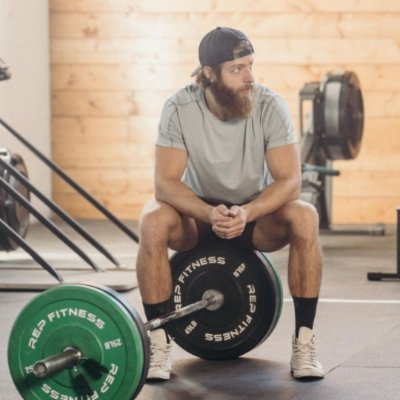So you want to find your estimated 1-rep max for your squat, bench press, and deadlift — it’s one of the few rights of passage for getting into strength training.
Even 12 years into my training career, I still love playing with this calculator after big doubles and triples to see where I estimate 1-rep max “could” be sitting.
Now, I know comparison is the thief of joy, but I’d be remiss not to acknowledge that a little competition can make training a lot more enjoyable. Below this calculator, I’m going to share some strength standards that I like to use in my day-to-day and with clients.
To find your bench press, squat, and deadlift estimated 1-rep max, plug in how much you lifted with the reps performed below.
1-Rep Max Calculator
Notes About The Calculator Above
This calculator utilizes The Brzycki formula (1).
This formula isn’t foolproof, but it does tend to do a pretty good job for most lifters and athletes. I’d give it an 80-90% confidence interval regarding its accuracy, at least for my lifts.
Two things to keep in mind when using calculators like this are:
- The higher the reps used in the calculator, the greater the chance of discrepancies. For example, you’ll typically get a more accurate estimated 1-RM off of a big double or triple versus a heavy set of 8-10.
- Why Is This: In my coaching opinion and experience, athletes handle higher volume tough sets A LOT differently from one another. For example, my ability to grind a heavy set of 8 versus another lifter can vary greatly, which will reflect in bigger estimated 1-RM spreads.
- The type of lift and muscle group being trained can also create discrepancies. Generally speaking, there’s more variance with deadlift 1-RMs when using this calculator than with bench press and squats.
- Why Is This: My theory is that, like high volume sets, deadlifts and our ability to grind them out can vary a TON compared to bench presses and squats. When you hit your wall with a bench and squat, it’s a lot more definitive, whereas with heavy deads, it can get a little greyer.

Men’s That Fit Friend Strength Standards
My dudes, curious how to stack up to the That Fit Friend community? The following standards are based on my 12 years of coaching experience.
This includes pulling numbers and observations from what I’ve witnessed training clients, with my own training, and what I’ve observed via feedback from my review videos, articles, and social media.
Also, keep in mind that, like with most strength standards, the following could be argued as “arbitrary,” and I totally agree with that sentiment. Most strength standards lack context, but it’s still fun to see how you stack up!
Note that my community tends to be hyped-focused on lifting, so these numbers may seem high to some.
| Squat Strength Standards | Bench Press Strength Standards | Deadlift Strength Standards |
| 18-25: 185-275 lbs exceptional, 275+ lbs elite | 18-25: 155-225 lbs exceptional, 225+ lbs elite | 18-25: 255-325 lbs exceptional, 325+ lbs elite |
| 26-35: 205-285 lbs exceptional, 285+ lbs elite | 26-35: 185-235 lbs exceptional, 235+ lbs elite | 26-35: 285-365 lbs exceptional, 365+ lbs elite |
| 36+: 195-275 lbs exceptional, 275+ lbs elite | 36+: 185-235 lbs exceptional, 235+ lbs elite | 36+: 265-335 lbs exceptional, 335+ lbs elite |
Women’s That Fit Friend Strength Standards
| Squat Strength Standards | Bench Press Strength Standards | Deadlift Strength Standards |
| 18-25: 145-225 lbs exceptional, 225+ lbs elite | 18-25: 105-145 lbs exceptional, 145+ lbs elite | 18-25: 185-265 lbs exceptional, 265+ lbs elite |
| 26-35: 165-235 lbs exceptional, 235+ lbs elite | 26-35: 115-155 lbs exceptional, 155+ lbs elite | 26-35: 205-275 lbs exceptional, 275+ lbs elite |
| 36+: 155-235 lbs exceptional, 235+ lbs elite | 36+: 105-145 lbs exceptional, 145+ lbs elite | 36+: 185-265 lbs exceptional, 265+ lbs elite |
Maybe we should forget the training ideology of getting “as strong as possible,” and instead, worry about getting “as strong as we need.”
How Often Should You Check Your Maxes?
That all depends. Can you check them often without losing sight of your main training goals?
If so, then check as often as you want. There’s no harm in using calculators to stay motivated and see what you “could” potentially do.
Conversely, if you’re someone who tends to get stressed by arbitrary goals and numbers, then you may want to check less often. Once at the beginning and the end of a training block is more than enough.
This will often give you enough time to see an improvement, whereas if you’re checking all of the time, then you may see more fluctuations due to the variance of energy and outputs we can experience on a day-to-day basis.
At the End of the Day
Use 1-rep max calculators to track progress and motivate you, but don’t hold them as an end-all-be-all for your training.
They can be fun tools to play with. However, they’re not often rooted in the reality of our training and daily life. What a calculator says we can do may be different from what we can actually do.
Enjoy the process and avoid putting pressure on yourself to uphold what the formula says and what random strength standards say you “should” be at.
There’s no rush to get strong as strong as possible, so have fun with it!
Need direction with your programming? Give my training app That Fit Friend Strength a try! I have a free 7-day trial and over 10 programs to choose from!
References
- Seo, D.-I., Kim, E., Fahs, C. A., Rossow, L., Young, K., Ferguson, S. L., … So, W.-Y. (2012). Reliability of the one-repetition maximum test based on muscle group and gender.







Andres Amell
yoo this is nice! makes me feel strong haha.
S: 355lbs
B: 235lbs
D: 435lbs
Andres Amell
yoo this is nice! makes me feel strong haha
S: 355lbs
B: 235lbs
D: 435lbs
Solid numbers, dude!